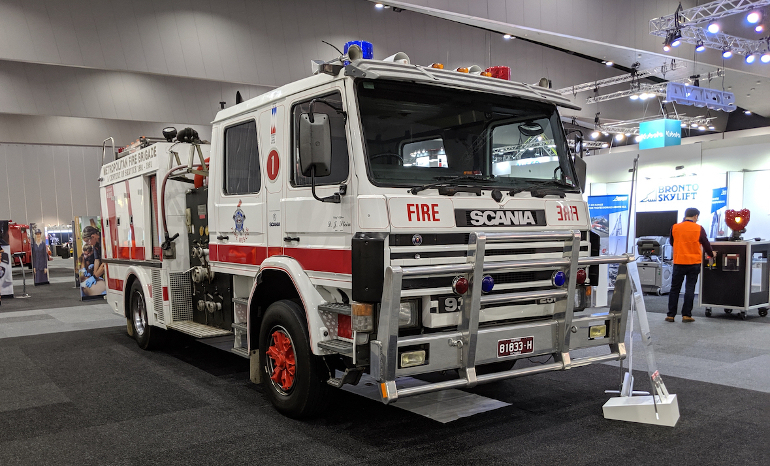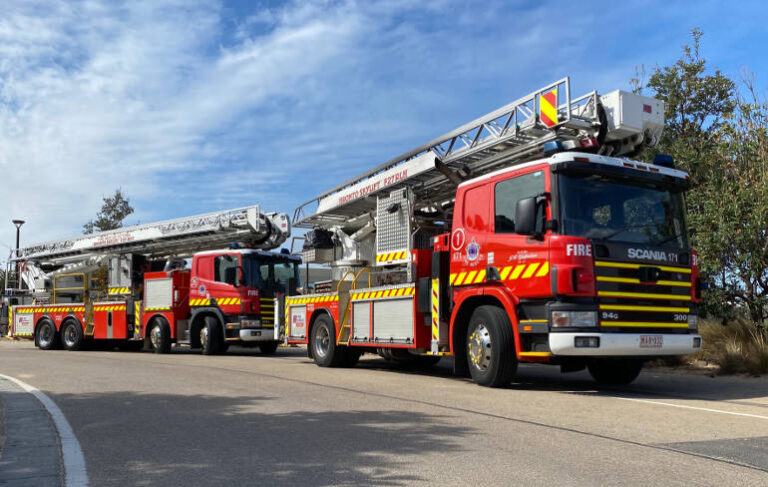Scania brings the future of fire-fighting and rescue into sharp focus at the 2023 AFAC Conference and Exhibition in Brisbane this August, displaying a state-of-the-art battery electric 4×2 rigid truck, as well as one of the most loved fire trucks of the recent past, a retired 3-series historic appliance, loaned by the Melbourne Metropolitan Fire Brigade’s museum.
“Scania drives the first response fleets of most Australian metropolitan and outer urban fire and rescue services, and has done so for a long while,” says Benjamin Nye, Director of Sales for Scania Trucks.
“Behind our success in providing heavy pumpers for urban and outer urban fire-fighting is a safe, comfortable spacious CrewCab platform that has proven itself in service over decades, and which is loved by the crews who drive and ride in it.
“Scania’s commitment to the fire services of Australia does not start and end with the provision of the powertrain and cab, but extends throughout the service life of the vehicle with bespoke maintenance and repair solutions that ensure high uptime, safe operation and deliver dependability for every cold start and high speed departure.
“Scania’s commitment to crew safety is unmatched in the industry, with four side curtain rollover protection airbags fitted as standard to our current Scania NTG and SUPER rigid CrewCab fire-fighting appliances,” Ben says.
Scania’s CrewCab is the only vehicle equipped with this unique – and award-winning – rollover side curtain airbag system. When Scania introduced this technology in 2016, it took an important step towards mitigating one of the most critical consequences of rollover accidents, where drivers or passengers are injured or even fatally crushed by their own vehicle. This clever solution deploys and protects seat-belted occupants if the truck happens to roll over.
“We see a growing demand for updated ergonomics, improved safety and solutions that are better adopted for operating in busy, urban environments like big cities,” Ben says. Firefighters need trucks that are easy to manoeuvre, which requires the driver to have good visibility and an agile vehicle to work with.
“We have fitted a driver airbag to the steering wheel for more than 15 years and we have had ABS, traction control and Advanced Emergency Braking on our fire trucks for a long time. These features ensure the teams aboard our CrewCabs remain safe on a high speed dash to an emergency,” he says.
“The seeds of our success providing fire-fighting appliance platforms can be traced back more than 100 years,” says Scott Slater, Scania Australia’s National Specialised Vehicle Manager.
“Scania has always been a keen supplier of safe and strong vehicles to the rescues services in Europe, and in more recent times, globally. The 2- and 3-series vehicles in particular became the workhorse of Australia’s metro fire fighters in the 1980s and 1990s, and were seamlessly succeeded by the 4-series and then the PGR series,” Scott says. “These vehicles are a common site in Europe, South America and increasingly in China and throughout Asia.
“There are more than 700 Scania-based fire appliances in service across Australia’s key fire-fighting services, and the 2023 AFAC Conference and Exhibition gives us the opportunity to present our view of the near future, with the first Scania-based battery electric rigid truck that could easily be utilised for rescue services.
“The Scania 25 P BEV on display at AFAC could be configured as a 4×2, 6×2 or 6×4 rigid chassis that is built on the P-series regular cab chassis. Alternatively it could be built on a Scania L-series low cab chassis, complete with an inward-opening glass City Door that makes entry and egress easier especially when wearing protective equipment,” he says.
The Scania L-series BEV solution also offers a 6×2*4 axle configuration (the third axle is an electrically steered tag axle), and a wheel base of 4,250 mm, with a GVM of up to 28 tonnes. With nine batteries, and 300 kWh of installed energy, the BEV offers a range of up to 250 km from the 230 kW electric machine.
Scania’s BEV chassis can therefore easily accommodate a rescue body or command centre. With fire appliances spending the majority of their time at the fire station, maintaining a full charge would be no problem, and the vehicle itself could be used to provide onsite power for fire-fighting or support tools during a rescue event, such as a road accident or search and rescue deployment.
Globally, battery electric vehicles are attracting more and more attention for firefighting purposes. An obvious upside is their ability to do the job at the location without creating noise or emissions.
“As Europe focusses more firmly on introducing battery electric vehicles into its transport and logistics fleets, as well as for vocational vehicles, it is patently obvious that attention will turn to the electrification of the fire-fighting fleets,” Benjamin Nye says.
“Scania will be at the forefront of this development naturally, given our pre-eminent position as a supplier of fire-fighting platforms, and the performance benefits of a BEV, particularly its step-off acceleration and its surfeit of torque, will be highly prized by fire service members when answering emergency calls,” he says.
With decades of experience delivering reliable service, future-proofed new generation zero tailpipe-emission product heading our way, and an unshakable commitment to supporting and servicing the fire-fighters and rescue teams of Australia’s emergency services, Scania remains the number one choice for the supply of emergency service platforms.
Scania 1991 Mark 3 Urban Firefighting Appliance

Scania has borrowed a 1991 Melbourne Metropolitan Fire Brigade pumper from the MFB Museum to display at AFAC to demonstrate the longevity of Scania’s commitment to supporting fire services across Australia.
This unit was commissioned in the Brigade’s centenary year, 1991, coinciding with Scania’s 100th birthday.
It was the first Scania to be operated by the MFB, and was fitted with a Mills Gitsham body. It has a 3800-litres per minute Darley 3-stage pump, an on board 1300-litre water tank and 300-litre foam tank, with a 3000 l/m monitor on the roof, along with a 9 m ladder.
The truck covered 270,000 km on active service and was eventually painted red when moving from its central Melbourne Fire Station to an outer suburban location. It was restored to its original white before being decommissioned in 2009 and presented to the Fire Services of Victoria Museum.
In 2016-17, Scania assisted in the further restoration of this and two other historic firefighting appliances, bringing them back to roadworthy condition.






